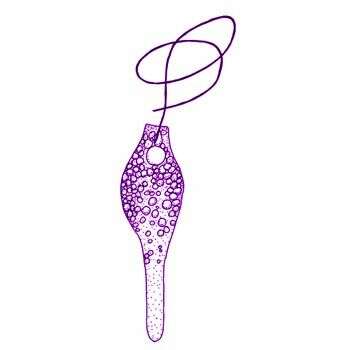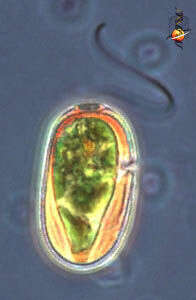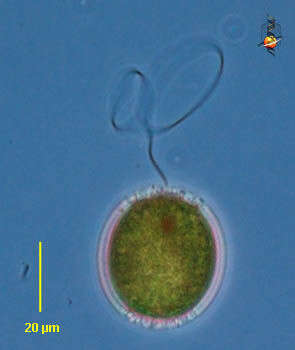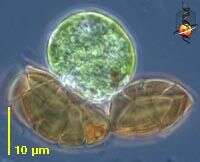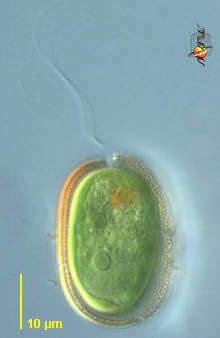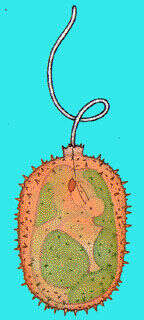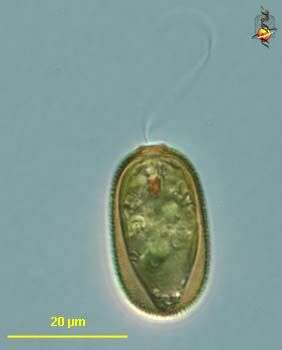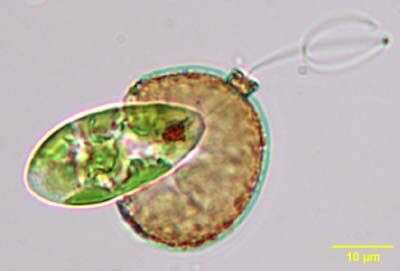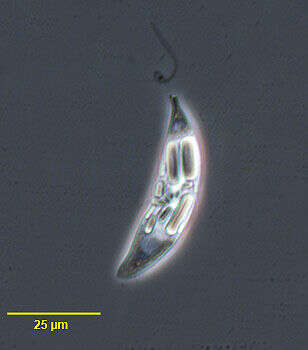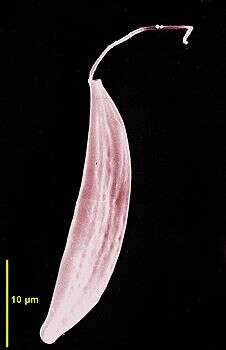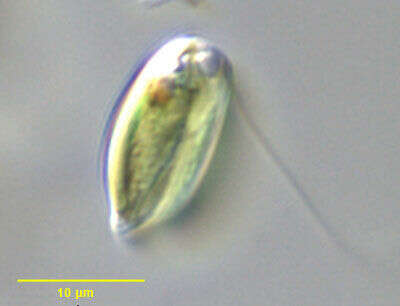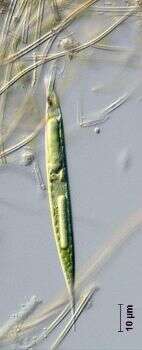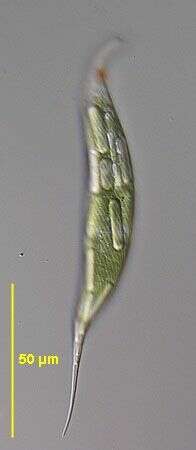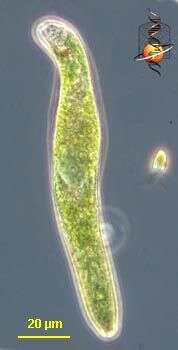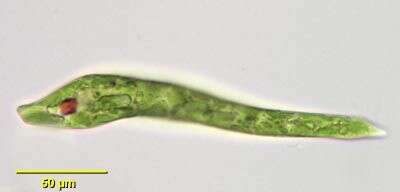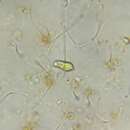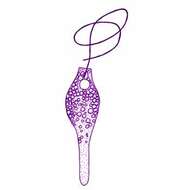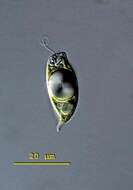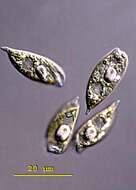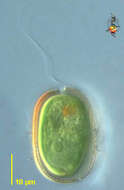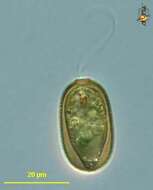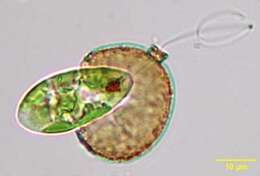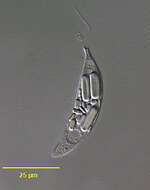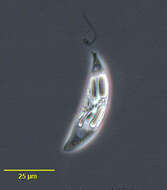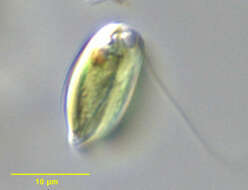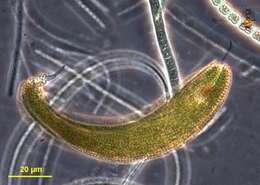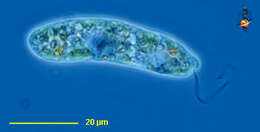-
Astasia ocellata Khawkine. Astasia in which the cells are oval, spindle-shaped or almost cylindrically, 35-65 microns long, 8-35 microns wide. Flagellum 1.5-2 times cell length. Nucleus central. Paramylon granules spherical to polyhedral.
-
Phacus (fake-us) is a genus of autotrophic euglenids. It can be distinguished from Euglena by being flattened or twisted and rigid. The most species of the genus are flat and leaf-shaped often with ridges or fins running helically or longitudinally. The chloroplasts are small, discoid and pyrenoids are usually absent. There is a single red eyespot and one locomotive flagellum. Phacus contains conspicuous paramylon bodies, mostly with one ore two large bodies in the centre of the cell. The genus is common in freshwater ecosystems, in muds and associated with detritus. This specimen was collected in freshwater ponds near Konstanz, Germany. Phacus skujai is a small member of the genus. The cells are slender and ovoid. The large paramylon body (often accompanied by a second smaller body) in the mid-cell and the short spine point to the ventral side are said to be distinctive for the species. 28 µm.
-
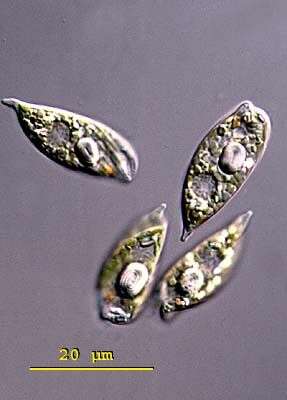
Phacus (fake-us) is a genus of autotrophic euglenids. It can be distinguished from Euglena by being flattened or twisted and rigid. The most species of the genus are flat and leaf-shaped often with ridges or fins running helically or longitudinally. The chloroplasts are small, discoid and pyrenoids are usually absent. There is a single red eyespot and one locomotive flagellum. Phacus contains conspicuous paramylon bodies, mostly with one ore two large bodies in the centre of the cell. The genus is common in freshwater ecosystems, in muds and associated with detritus. This specimen was collected in freshwater ponds near Konstanz, Germany. Phacus skujai is a small member of the genus. The cells are slender and ovoid. The large paramylon body (often accompanied by a second smaller body) in the mid-cell and the short spine point to the ventral side are said to be distinctive for the species. These cells are 'starved', the large paramylon body is considerably reduced and the nucleus is visible. 28 µm.
-
Trachelomonas (track-ell-owe-moan-ass) is an autotrophic euglenid flagellate. The genus is distinguished from others because the cells live within a loose fitting lorica with a small opening. The lorica of many species is elaborated with spikes or spines. The lorica accumulates metal salts with age, becoming brown and brittle and often obscuring the bright green colour of the chloroplasts within the cell. Red eyespot evident as dark region near the anterior of the cell. There is one emergent flagellum which emerges from the opening of the lorica. After division of the daughter cells will emerge from the opening of the lorica. Most freshwater but occasionally found in brackish habitats. Phase contrast.
-
Trachelomonas (track-ell-owe-moan-ass) is an autotrophic euglenid flagellate. The genus is distinguished from others because the cells live within a loose fitting lorica with a small opening. The lorica of many species is elaborated with spikes or spines. The lorica accumulates metal salts with age, becoming brown and brittle and often obscuring the bright green colour of the chloroplasts within the cell. Red eyespot evident as dark region near the anterior of the cell. There is one emergent flagellum which emerges from the opening of the lorica. After division of the daughter cells will emerge from the opening of the lorica. Most freshwater but occasionally found in brackish habitats. Phase contrast.
-
Trachelomonas (track-ell-owe-moan-ass) is an autotrophic euglenid flagellate. The genus is distinguished from others because the cells live within a loose fitting lorica with a small opening. The lorica of many species is elaborated with spikes or spines. The lorica accumulates metal salts with age, becoming brown and brittle and often obscuring the bright green colour of the chloroplasts within the cell. Red eyespot evident as dark region near the anterior of the cell. There is one emergent flagellum which emerges from the opening of the lorica. After division of the daughter cells will emerge from the opening of the lorica. Most freshwater but occasionally found in brackish habitats. Phase contrast.
-
Trachelomonas (track-ell-owe-moan-ass) is an autotrophic euglenid flagellate. The genus is distinguished from others because the cells live within a loose fitting lorica with a small opening. The lorica of many species is elaborated with spikes or spines. The lorica accumulated metal salts with age, becoming brown and brittle - as is evident here. The lorica usually obscures the bright green colour of the chloroplasts within the cell. Red eyespot evident as dark region near the anterior of the cell. There is one emergent flagellum which emerges from the opening of the lorica. After division of the daughter cells will emerge from the opening of the lorica. Most freshwater but occasionally found in brackish habitats. Phase contrast.
-
Trachelomonas (track-ell-owe-moan-ass) is an autotrophic euglenid flagellate. The genus is distinguished from others because the cells live within a loose fitting lorica with a small opening. The lorica of many species is elaborated with spikes or spines. The lorica accumulates metal salts with age, becoming brown and brittle and often obscuring the bright green colour of the chloroplasts within the cell. Red eyespot evident near the anterior of the cell. There is one emergent flagellum which emerges from the opening of the lorica. After division of the daughter cells will emerge from the opening of the lorica. Most freshwater but occasionally found in brackish habitats. Phase contrast.
-
-
Trachelomonas (track-ell-owe-moan-ass) is an autotrophic euglenid flagellate. The genus is distinguished from others because the cells live within a loose fitting lorica with a small opening. The lorica of many species is elaborated with spikes or spines. The lorica accumulates metal salts with age, becoming brown and brittle and often obscuring the bright green colour of the chloroplasts within the cell. Red eyespot evident near the anterior of the cell. There is one emergent flagellum which emerges from the opening of the lorica. Most freshwater but occasionally found in brackish habitats. Differential interference contrast.
-
Portrait of Trachelomonas, a loricate euglenoid flagellate. Lorica in this species has distinct collar with an aperture through which a single flagellum emerges. The lorica has been fractured exposing the cell body with its prominent stigma and thin discoid peripheral plastids. From freshwater pond near Boise, Idaho.Brightfield.
-
Portrait of the colorless euglenoid flagellate, Menoidium bibacillatum (Pringsheim, 1942). Strongly flattened. One side curved with the other more straight. One emergent flagellum. Stigma absent. Paramylon bodies are dimorphic with smaller round and larger elongate ring forms. Swims rotating on long axis. Highly refractile. From standing freshwater near Boise, Idaho. DIC.
-
Portrait of the colorles euglenoid flagellate,Menoidium bibacillatum (Pringsheim, 1942). Strongly flattened. One side curved with the other more straight. One emergent flagellum. Stigma absent. Paramylon bodies are dimorphic with smaller round and larger elongate ring forms. Swims rotating on long axis. Highly refractile. From standing freshwater near Boise, Idaho. Phase contrast.
-
Scanning electron micrograph showing the anterior flagellum and the cell shape.
-
Cryptoglena pigra. Although Cryptoglena has been considered a euglenid flagellate the genus should probably be considered of uncertain affinity. The cells are solitary and have a single emergent flagellum slightly longer than the cell body. The cell body is rigid, dorsoventrally flattened and ovoid in outline with rounded anterior and bluntly pointed posterior. There is an obvious longitudinal furrow seen well in this image. Described as having one or two laminate parietal chloroplasts without pyrenoids. The posterior nucleus is not visible in this image. The prominent anterior stigma is seen well here. The genus has been described as monospecific by some authors and as containing five or six species by others. From a slow flowing freshwater stream near Boise, Idaho. Differential interference contrast illumination.
-
Portrait of euglena acus (Ehrenberg,1830). Cell body is an elongate cylinder with a sharply pointed posterior end. The flagellum is about one-fourth the body length; Delicate pellicular striations are difficult to see without DI. The small discoid chloroplasts are numerous. Paramylon bodies are rod-shaped. The nucleus iscentral. The stigma is prominen. Moves sluggishly among debris. Collected from the slow-moving organically enriched outflow from a pond near Boise, Idaho. DIC.
-
Scanning electron micrograph.
-
Portrait of Euglena acus (Ehrenberg,1830). Cell body is an elongate cylinder with a sharply pointed posterior end. The flagellum is about one-fourth the body length; Delicate pellicular striations are difficult to see without DIC. The small discoid chloroplasts are numerous. Paramylon bodies are rod-shaped. The nucleus is central. The stigma is prominent. Moves sluggishly among debris. Collected from a freshwater pond near Boise, Idaho. September 2006.DIC
-
Surface view of Euglena acus (Ehrenberg,1830). Cell body is an elongate cylinder with a sharply pointed posterior end. The flagellum is about one-fourth the body length; Delicate pellicular striations are visible here. The small discoid chloroplasts are numerous. Paramylon bodies are rod-shaped. The nucleus is central. The stigma is prominent. Moves sluggishly among debris. Collected from a freshwater pond near Boise, Idaho. September 2006.DIC
-
Euglena spirogyra (EHRENBERG, 1831), elongate gliding species distinguished by warty surface. This species with numerous paramylon granules, but two of these are very large. From freshwater pond near Boise, Idaho.
-
Euglena spirogyra (EHRENBERG, 1831). Cell observed in freshwater habitats in the vicinity of Broome, Western Australia in September 2003. This image was taken using phase contrast optics. This work was supported by the Australian Biological Resources Study.
-
Euglena deses is a worm like gliding Euglena which rarely swims (ignore the Tetraselmis to the right) is one of a group of worm-like species, either with very short flagella or no emergent flagellum. They rely on gliding to make their way through the substrate. Very metabolic. E. deses is distinguished by the rather similar E. mutabilis by the large numbers of plastids (individual plastids cannot be seen in this micrograph). The red spot is the stigma or eye-spot, the nucleus is the grey zone in the centre of the cell. Phase contrast.
-
Euglena deses. Brightfield portrait of slender very plastic elongate species. Anterior end rounded. Posterior end tapers rather bluntly. Short emergent flagellum not seen here. Chloroplasts are relatively large flat and round or polygonal in outline. Prominent eyespot. Found among decaying leaves on bottom of freshwater pond near Boise, Idaho in October 2002.
-
Euglena gracilis (you-glean-a grass-ill-iss). Euglena is the iconic genus of euglenoid flagellates, and this is probably the most familiar of the species. The body of most euglenids is typically spindle-shaped, although two flagella arise in a pocket within the cell only one emerges (and sometimes none). The body can squirm, and the cell has one to many chloroplasts. At the anterior of the body a thin channel (flagellar canal) leads to the flagellar pocket, and alongside this is a contractile vacuole. A red eyespot or stigma is associated with the bottom of the flagellar canal. This image shows the nucleus (central). the region of the flagellar pocket as the lighter region to the right, the associated stigma, the single emergent flagellum, and several green chloroplasts. Phase contrast.

